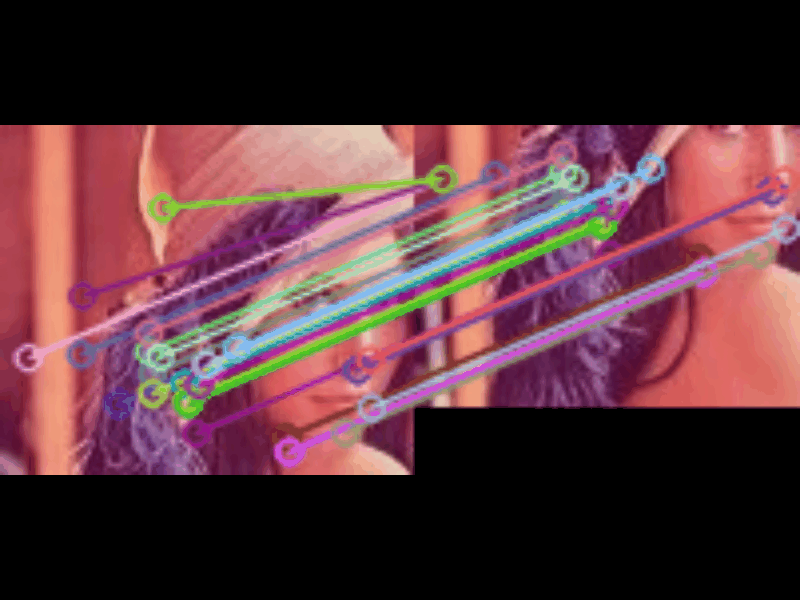💭
複数の切り取り画像から元の画像を復元する
はじめに
複数の切り取り画像から元画像を復元したかったため、Pythonにやってもらいました。
目的
複数の切り取り画像を入力として、それらを結合し大きい元画像を出力します。
インプット
複数の切り取り画像
前提として、各画像間で共通の箇所が写っていることとします。






アウトプット
元画像
以下のようになってほしい

コード
画像のディレクトリに読み込んだ後に、
1つ目の画像と2つ目の画像の共通する特徴点を算出し、それがマッチするかのように合成する。
その後、合成画像に3つ目の画像、4つ目の画像、…、とどんどん特徴点算出と合成を繰り返し、
ディレクトリの画像がすべてなくなるまで行います。
import cv2
import numpy as np
import glob
import os
# 画像が保存されているディレクトリのパス
image_dir = 'img/'
# 対応する画像ファイルのパスを取得
image_files = []
for ext in ('*.png', '*.jpg', '*.jpeg', '*.bmp'):
image_files.extend(glob.glob(os.path.join(image_dir, ext)))
# 特徴点検出器を初期化 (SIFT)
sift = cv2.SIFT_create()
# 最初の画像を読み込む
base_img = cv2.imread(image_files[0])
for image_path in image_files[1:]:
next_img = cv2.imread(image_path)
# 現在の画像(base_img)と次の画像(next_img)の特徴点と記述子を検出
kp1, des1 = sift.detectAndCompute(base_img, None)
kp2, des2 = sift.detectAndCompute(next_img, None)
# BFMatcherでマッチング
bf = cv2.BFMatcher(cv2.NORM_L2)
matches = bf.knnMatch(des1, des2, k=2)
# 良いマッチを選別
good_matches = []
for m, n in matches:
if m.distance < 0.75 * n.distance:
good_matches.append(m)
# 良いマッチング点が十分にあるか確認
if len(good_matches) > 10:
# キーポイントの座標を抽出
src_pts = np.float32([kp1[m.queryIdx].pt for m in good_matches]).reshape(-1, 1, 2)
dst_pts = np.float32([kp2[m.trainIdx].pt for m in good_matches]).reshape(-1, 1, 2)
# ホモグラフィ行列を計算
H, mask = cv2.findHomography(src_pts, dst_pts, cv2.RANSAC, 5.0)
# base_imgの四隅を変換して、キャンバスの範囲を確認
h1, w1 = base_img.shape[:2]
h2, w2 = next_img.shape[:2]
base_img_corners = np.float32([[0, 0], [0, h1], [w1, h1], [w1, 0]]).reshape(-1, 1, 2)
base_img_transformed_corners = cv2.perspectiveTransform(base_img_corners, H)
# 結合後のキャンバスの範囲を計算
combined_corners = np.concatenate((base_img_transformed_corners, np.float32([[0, 0], [0, h2], [w2, h2], [w2, 0]]).reshape(-1, 1, 2)), axis=0)
[x_min, y_min] = np.int32(combined_corners.min(axis=0).ravel())
[x_max, y_max] = np.int32(combined_corners.max(axis=0).ravel())
# 平行移動の調整
translation_dist = [-x_min, -y_min]
H_translation = np.array([[1, 0, translation_dist[0]], [0, 1, translation_dist[1]], [0, 0, 1]])
# base_imgを変換して、新しいキャンバスに描画
result_img = cv2.warpPerspective(base_img, H_translation.dot(H), (x_max - x_min, y_max - y_min))
# 次の画像を結果に配置
result_img[translation_dist[1]:h2 + translation_dist[1], translation_dist[0]:w2 + translation_dist[0]] = next_img
# 次の画像を結合結果として更新
base_img = result_img
else:
print(f"画像 {image_path} で十分なマッチングポイントがありません")
# 最終結果を表示
cv2.imshow('Result', base_img)
cv2.waitKey(0)
cv2.destroyAllWindows()
]
結果

ところどころ歪んでる…。
変に変形させる必要なかった。
おわりに
複数の切り取り画像を入力として、それらを結合し大きい元画像を出力しました。
大きい画像をいきなり1枚の画像に収めることが難しい場合に使えると思います。
追記
回転、せん断、拡大縮小をせず、平行移動だけで1枚の画像にしていきます。
import cv2
import numpy as np
import glob
import os
# 画像が保存されているディレクトリのパス
image_dir = 'img/' # ディレクトリのパスを指定
image_files = []
for ext in ('*.png', '*.jpg', '*.jpeg', '*.bmp'):
image_files.extend(glob.glob(os.path.join(image_dir, ext)))
# 特徴点検出器の初期化 (SIFT)
sift = cv2.SIFT_create()
bf = cv2.BFMatcher(cv2.NORM_L2)
# 最初の画像を基準に設定
base_img = cv2.imread(image_files[0])
# 順次合成結果を更新
for image_path in image_files[1:]:
next_img = cv2.imread(image_path)
# 基準画像と次の画像で特徴点を検出
kp1, des1 = sift.detectAndCompute(base_img, None)
kp2, des2 = sift.detectAndCompute(next_img, None)
# 特徴点のマッチングと比率テストで良いマッチを選別
matches = bf.knnMatch(des1, des2, k=2)
good_matches = [m for m, n in matches if m.distance < 0.7 * n.distance] # ここの比率を下げれば精度が良いマッチング結果だけ残せる
# マッチング結果を描画して確認
match_img = cv2.drawMatches(base_img, kp1, next_img, kp2, good_matches, None, flags=cv2.DrawMatchesFlags_NOT_DRAW_SINGLE_POINTS)
cv2.imshow('Feature Matching', match_img)
cv2.waitKey(500) # 0にすると一時停止。500にすると0.5秒表示。
# マッチが不足している場合はスキップ
if len(good_matches) < 10:
print(f"画像 {image_path} のマッチングが不十分です。次の画像に進みます。")
continue
# RANSACを使用して平行移動のみのアフィン変換行列を推定
src_pts = np.float32([kp1[m.queryIdx].pt for m in good_matches]).reshape(-1, 1, 2)
dst_pts = np.float32([kp2[m.trainIdx].pt for m in good_matches]).reshape(-1, 1, 2)
M, inliers = cv2.estimateAffinePartial2D(dst_pts, src_pts, method=cv2.RANSAC, ransacReprojThreshold=5.0)
if M is None:
print("変換行列が見つかりませんでした。次の画像に進みます。")
continue
# 平行移動量を取得
translation = M[:, 2].astype(int)
# キャンバスのサイズを計算
h1, w1 = base_img.shape[:2]
h2, w2 = next_img.shape[:2]
x_min = min(0, translation[0])
y_min = min(0, translation[1])
x_max = max(w1, w2 + translation[0])
y_max = max(h1, h2 + translation[1])
# キャンバスを作成して画像を配置
translation_dist = [-x_min, -y_min]
result_img = np.zeros((y_max - y_min, x_max - x_min, 3), dtype=np.uint8)
# 基準画像をキャンバスに配置
result_img[translation_dist[1]:h1 + translation_dist[1], translation_dist[0]:w1 + translation_dist[0]] = base_img
# 次の画像を平行移動して配置
x_offset = translation_dist[0] + translation[0]
y_offset = translation_dist[1] + translation[1]
result_img[y_offset:y_offset + h2, x_offset:x_offset + w2] = next_img
# 合成結果を更新
base_img = result_img
cv2.imshow("Result", base_img)
cv2.imwrite("Result.png", base_img)
cv2.waitKey(0)
cv2.destroyAllWindows()

こうなります。
さらに追記
cv2.phaseCorrelate()という関数がありました。
平行移動のみの位置合わせの場合、これで対応できるようです。
ディレクトリ内の画像を順番に読み込み、隣り合う画像同士をcv2.phaseCorrelateで自動的に位置合わせして合成。
その合成処理を繰り返し、最終的に画像が1枚になるか、合成できなくなるまで続けます。
最後に合成後の画像からは黒い余白部分をカットして完成です。
import cv2
import numpy as np
import os
def compute_shift(img1_gray, img2_gray):
"""シフト量と確信度を計算"""
win_size = (img1_gray.shape[1], img1_gray.shape[0])
win = cv2.createHanningWindow(win_size, cv2.CV_32F)
img1_gray_win = img1_gray * win
img2_gray_win = img2_gray * win
shift, response = cv2.phaseCorrelate(img1_gray_win, img2_gray_win)
return shift, response
def pad_images_to_same_size(images):
"""画像を同じサイズにパディングする"""
max_height = max(img.shape[0] for img in images)
max_width = max(img.shape[1] for img in images)
padded_images = []
for img in images:
h, w = img.shape[:2]
top = (max_height - h) // 2
bottom = max_height - h - top
left = (max_width - w) // 2
right = max_width - w - left
img_padded = cv2.copyMakeBorder(
img, top, bottom, left, right, cv2.BORDER_CONSTANT, value=[0, 0, 0]
)
padded_images.append(img_padded)
return padded_images
def crop_black_borders(img):
"""黒い余白をトリミングする"""
gray = cv2.cvtColor(img, cv2.COLOR_BGR2GRAY)
_, thresh = cv2.threshold(gray, 1, 255, cv2.THRESH_BINARY)
contours, _ = cv2.findContours(
thresh, cv2.RETR_EXTERNAL, cv2.CHAIN_APPROX_SIMPLE
)
if contours:
cnt = max(contours, key=cv2.contourArea)
x, y, w, h = cv2.boundingRect(cnt)
cropped_img = img[y : y + h, x : x + w]
return cropped_img
else:
return img
def assemble_images(images, positions):
"""各画像を指定された位置に配置して合成する(黒色を無視)"""
xs = [pos[0] for pos in positions]
ys = [pos[1] for pos in positions]
widths = [img.shape[1] for img in images]
heights = [img.shape[0] for img in images]
x_min = int(np.floor(min(xs)))
y_min = int(np.floor(min(ys)))
x_max = int(np.ceil(max([x + w for x, w in zip(xs, widths)])))
y_max = int(np.ceil(max([y + h for y, h in zip(ys, heights)])))
canvas_width = x_max - x_min
canvas_height = y_max - y_min
canvas = np.zeros((canvas_height, canvas_width, 3), dtype=np.uint8)
for img, (x, y) in zip(images, positions):
x_offset = int(round(x - x_min))
y_offset = int(round(y - y_min))
h, w = img.shape[:2]
x_start = x_offset
y_start = y_offset
x_end = x_offset + w
y_end = y_offset + h
canvas_region = canvas[y_start:y_end, x_start:x_end]
# マスクの作成と次元の拡張
mask = cv2.cvtColor(img, cv2.COLOR_BGR2GRAY) > 0
mask_3d = mask[:, :, np.newaxis]
mask_3d = np.repeat(mask_3d, 3, axis=2)
# マスクを使用して黒色以外のピクセルをコピー
canvas_region[mask_3d] = img[mask_3d]
return canvas
def merge_images_group(images, threshold):
"""画像をグループ化して結合する"""
merged_groups = []
current_group = [images[0]]
positions = [(0.0, 0.0)]
cumulative_dx = 0.0
cumulative_dy = 0.0
gray_images = [cv2.cvtColor(img, cv2.COLOR_BGR2GRAY).astype(np.float32) for img in images]
for i in range(len(images) - 1):
img1_gray = gray_images[i]
img2_gray = gray_images[i + 1]
shift, response = compute_shift(img1_gray, img2_gray)
if response >= threshold:
dx, dy = shift
cumulative_dx -= dx
cumulative_dy -= dy
positions.append((cumulative_dx, cumulative_dy))
current_group.append(images[i + 1])
else:
merged_img = assemble_images(current_group, positions)
merged_groups.append(merged_img)
current_group = [images[i + 1]]
positions = [(0.0, 0.0)]
cumulative_dx = 0.0
cumulative_dy = 0.0
if current_group:
merged_img = assemble_images(current_group, positions)
merged_groups.append(merged_img)
return merged_groups
def recursive_merge(images, threshold):
"""再帰的に画像を結合する"""
previous_length = len(images)
iteration = 0
while True:
iteration += 1
print(f"Iteration {iteration}: {len(images)} images")
images = pad_images_to_same_size(images)
merged_images = merge_images_group(images, threshold)
current_length = len(merged_images)
if current_length == previous_length:
break
images = merged_images
previous_length = current_length
if current_length == 1:
break
return images
def merge_images_in_directory(directory_path, threshold=0.2):
"""ディレクトリ内の画像を再帰的に合成する"""
image_files = sorted(
[
f
for f in os.listdir(directory_path)
if f.lower().endswith((".png", ".jpg", ".jpeg"))
]
)
if not image_files:
print("画像がディレクトリに見つかりませんでした。")
return None
images = [cv2.imread(os.path.join(directory_path, f), cv2.IMREAD_COLOR) for f in image_files]
merged_images = recursive_merge(images, threshold)
for idx, merged_img in enumerate(merged_images):
final_image = crop_black_borders(merged_img)
cv2.imwrite(f"output/merged_result_{str(idx+1).zfill(5)}.png", final_image)
print(f"結合画像を保存しました: merged_result_{idx+1}.png")
print("全ての画像の結合が完了しました。")
return merged_images
# 使用例
if __name__ == "__main__":
directory = "img" # 画像が保存されているディレクトリのパスに置き換えてください
merge_images_in_directory(directory, threshold=0.25)

近傍以外も結合したい場合
def merge_images_group(images, threshold):
"""
画像をすべての連鎖に対してチェインベースでグループ化して結合する。
Args:
images (list of np.array): 画像のリスト
threshold (float): 相関度の閾値
iteration (int): 現在のイテレーション番号
Returns:
list of np.array: 合成されたグループ画像のリスト
"""
if not images:
return []
merged_groups = []
gray_images = [cv2.cvtColor(img, cv2.COLOR_BGR2GRAY).astype(np.float32) for img in images]
n = len(images)
used = set()
for i in range(n):
if i in used:
continue
# 新しいグループを開始
group_imgs = [images[i]]
positions = [(0.0, 0.0)]
cumulative_dx = 0.0
cumulative_dy = 0.0
used.add(i)
current_idx = i
# 現在のグループのベース画像
base_gray = gray_images[current_idx]
# 続けてさらにマッチを探す(チェインを伸ばす)
while True:
found = False
for j in range(current_idx + 1, n):
if j in used:
continue
img_gray = gray_images[j]
shift, response = compute_shift(base_gray, img_gray)
if response >= threshold:
dx, dy = shift
cumulative_dx -= dx
cumulative_dy -= dy
positions.append((cumulative_dx, cumulative_dy))
group_imgs.append(images[j])
used.add(j)
base_gray = img_gray
current_idx = j
found = True
break
if not found:
break
merged_img = assemble_images(group_imgs, positions)
merged_img = crop_black_borders(merged_img)
merged_groups.append(merged_img)
return merged_groups
ベンチマーク作成用コード
import cv2
import os
def split_image_with_overlap_snake(input_image_path, output_dir, tile_width, tile_height, overlap_ratio=0.1):
"""画像をオーバーラップ付きで蛇状に分割して保存します"""
os.makedirs(output_dir, exist_ok=True)
image = cv2.imread(input_image_path)
img_height, img_width = image.shape[:2]
# オーバーラップするピクセル数を計算
overlap_w = int(tile_width * overlap_ratio)
overlap_h = int(tile_height * overlap_ratio)
tile_id = 0 # 分割画像のカウント
max_tiles = (img_height // tile_height) * (img_width // tile_width) # 推定の最大タイル数
# 縦方向のループ
for y in range(0, img_height - tile_height + 1, tile_height - overlap_h):
# 奇数行と偶数行でxの方向を変更(蛇状)
if (y // (tile_height - overlap_h)) % 2 == 0:
x_range = range(0, img_width - tile_width + 1, tile_width - overlap_w)
else:
x_range = range(img_width - tile_width, -1, -(tile_width - overlap_w))
# 横方向のループ
for x in x_range:
tile = image[y:y + tile_height, x:x + tile_width]
# ファイル名をゼロパディングで作成して保存
tile_filename = f"tile_{tile_id:04d}.png" # 4桁ゼロパディング
tile_path = os.path.join(output_dir, tile_filename)
cv2.imwrite(tile_path, tile)
print(f"Saved {tile_path}")
tile_id += 1
# 使用例
input_image_path = "image.png" # 大きな画像のパス
output_dir = "path/to/output_tiles" # 分割画像を保存するディレクトリ
tile_width = 256 # 分割後の画像の幅
tile_height = 256 # 分割後の画像の高さ
overlap_ratio = 0.7 # 70%のオーバーラップ
split_image_with_overlap_snake(input_image_path, output_dir, tile_width, tile_height, overlap_ratio)
Discussion